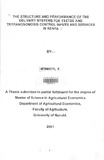| dc.contributor.author | M'mboyi, F | |
| dc.date.accessioned | 2013-05-08T10:20:20Z | |
| dc.date.available | 2013-05-08T10:20:20Z | |
| dc.date.issued | 2001 | |
| dc.identifier.citation | M'mboyi, F(2001).The structure and performance of the delivery systems for Tsetse and Trypanosomosis control inputs and services in Kenya | en |
| dc.identifier.uri | http://erepository.uonbi.ac.ke:8080/xmlui/handle/123456789/20259 | |
| dc.description | Msc-Thesis | en |
| dc.description.abstract | This study alms at Identifying the existing institutional framework involved in the delivery
of tsetse and trypanosomosis control inputs and services in Kenya with a view to determining
whether efficiency exists or not in the marketing system. The study also aims at identifying the
appropriate institutional framework that enhances efficiency in the marketing system for delivery
of these control inputs.
The marketing structure is analysed by 100k111gat the market share of the first four and first
eight largest traders within the various channels of the tsetse and trypanosomosis control inputs
marketing system. The results of analysis show that the wholesale marketing channel is the least
competitive, followed by the pharmaceutical firms and the retail traders. According to the Bain
(1968) industry classification model, there is evidence of a highly concentrated marketing system
amongst the wholesale traders while the pharmaceutical firms and the retail traders have a high to
moderate market concentration. The marketing structure was therefore found to be inherently
imperfectly competitive and was characterized by both monopolistic and oligopolistic features.
The extent of market efficiency is then analysed by looking at the market performance
indicators in this market viz a viz gross mat-gins per trading level, variable costs, opportunity cost
analysis and returns to capital investments per trading level. The results of analysis show that
there is evidence of inefficiency 111all the studied marketing firms. The least efficient marketing
channel was that controlled by the retail traders, followed by the wholesale traders. The relatively
inefficient marketing channel was that controlled by the pharmaceutical firms. The results of
analysis show that the retail traders had the highest returns to capital while the pharmaceutical
firms had the least returns to capital.
Although the liberalisation regirne was bemg put in place in the livestock health sector, it
was evident that the role of the government in dealing with the tsetse problem was not adequate
as observed by the diminishing budgetary allocations to the Livestock heath sector and the
reduced tsetse surveillance programs necessary to monitor the tsetse belts and spread of 'fly' 111
new pasture lands.
The research therefore indicated that imperfectness and non competitiveness was
inherently visible in the tsetse and trypanosomosis control inputs and services marketing system
and that there was urgent need for a policy intervention to remedy the situation. Some of the
proposed policy recommendations included: forming of livestock farmers co-operatives to
purchase tsetse control inputs at a lower per unit cost due to economies of scale; encouraging
more wholesale traders to enter the wholesale channel in order to break the current cycle of their
oligopolistic marketing structure; reducing information asymmetry in the market by bridging the
information gap between livestock farmers and the marketing institutions.
It is therefore concluded that further research has to be undertaken to ascertain the
functioning of pharmaceutical firms especially in the area of pricing. This would give a clear
indication of how these firms make their trading decisions and the resultant effect such an action
would have in influencing the behaviour of the retail traders, the wholesale traders and the
Al1ImaJ Health Service Providers. More research is still needed in this area because currently,
there is very little information database from which to draw inferences on the true situation in the
present tsetse and trypanosomosis control inputs and services marketing system in Kenya. | en |
| dc.description.sponsorship | University of Nairobi | en |
| dc.language.iso | en | en |
| dc.subject | Structure and performance | en |
| dc.subject | Delivery systems | en |
| dc.subject | Tsetse and trypanosomosis control | en |
| dc.subject | Inputs and services | en |
| dc.subject | Kenya | en |
| dc.title | The structure and performance of the delivery systems for Tsetse and Trypanosomosis control inputs and services in Kenya | en |
| dc.type | Thesis | en |
| local.publisher | Department of Agricultural Economics, University of Nairobi, Kenya | en |

